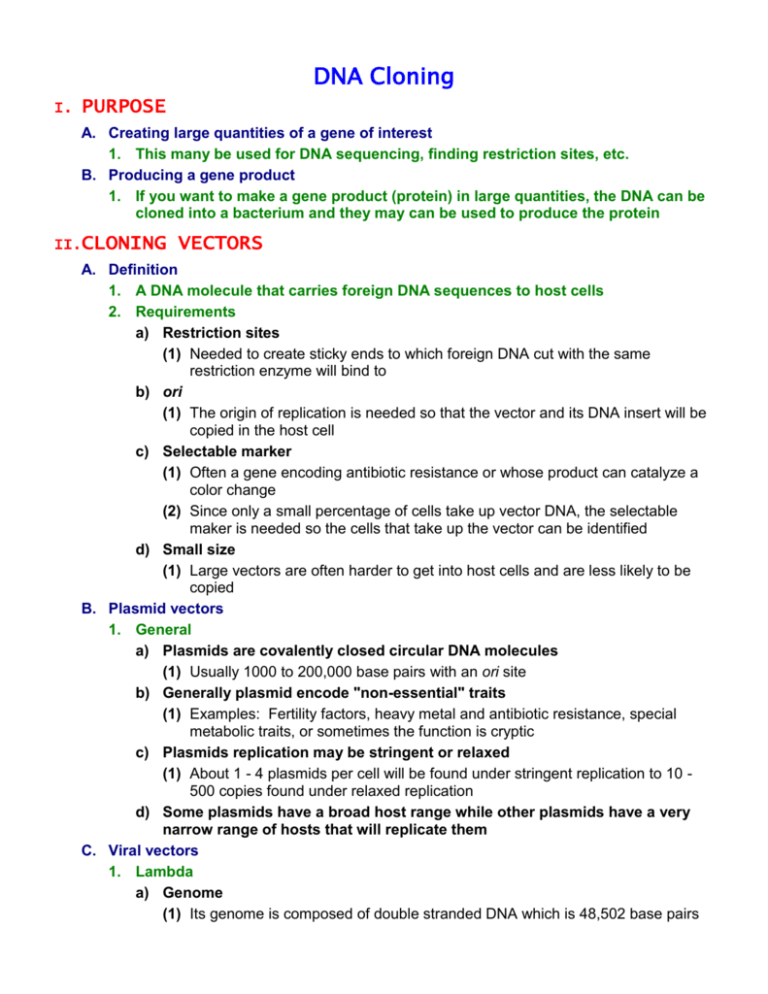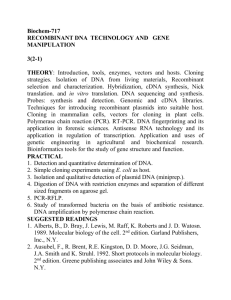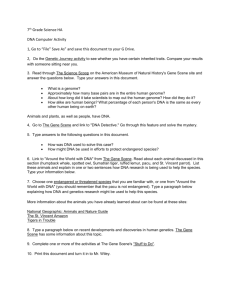DNA Replication
advertisement

DNA Cloning I. PURPOSE A. Creating large quantities of a gene of interest 1. This many be used for DNA sequencing, finding restriction sites, etc. B. Producing a gene product 1. If you want to make a gene product (protein) in large quantities, the DNA can be cloned into a bacterium and they may can be used to produce the protein II.CLONING VECTORS A. Definition 1. A DNA molecule that carries foreign DNA sequences to host cells 2. Requirements a) Restriction sites (1) Needed to create sticky ends to which foreign DNA cut with the same restriction enzyme will bind to b) ori (1) The origin of replication is needed so that the vector and its DNA insert will be copied in the host cell c) Selectable marker (1) Often a gene encoding antibiotic resistance or whose product can catalyze a color change (2) Since only a small percentage of cells take up vector DNA, the selectable maker is needed so the cells that take up the vector can be identified d) Small size (1) Large vectors are often harder to get into host cells and are less likely to be copied B. Plasmid vectors 1. General a) Plasmids are covalently closed circular DNA molecules (1) Usually 1000 to 200,000 base pairs with an ori site b) Generally plasmid encode "non-essential" traits (1) Examples: Fertility factors, heavy metal and antibiotic resistance, special metabolic traits, or sometimes the function is cryptic c) Plasmids replication may be stringent or relaxed (1) About 1 - 4 plasmids per cell will be found under stringent replication to 10 500 copies found under relaxed replication d) Some plasmids have a broad host range while other plasmids have a very narrow range of hosts that will replicate them C. Viral vectors 1. Lambda a) Genome (1) Its genome is composed of double stranded DNA which is 48,502 base pairs in length (a) It generally forms a circle due to its cohesive ends or cos sites (i) The cohesive ends are 12 nucleotide "sticky ends" found at its 5' end b) Genomic map (1) The head and tail proteins are encoded on the left portion of the genome (2) Control of lysogeny is encoded in the middle of the genome (a) This information is not needed for the lytic cycle (b) It is this portion of the genome which is removed and cloned DNA inserted (3) Genes for host cell lysis are encoded on the right portion of the genome c) Cloning procedure (1) Digest with restriction enzymes (a) This will create sticky ends and separate the left and right arms from the middle DNA (2) Electrophorese to separate arms (3) Add DNA to be cloned to the arms (a) This DNA must be cut with the same restriction enzyme as that used to cut the lambda genome, so the sticky ends will be complimentary (4) Ligate d) Selectable markers (1) Lambda with T5 A3 gene (a) The A3 gene is not compatible with Col1b plasmid (b) Only lambda with the A3 removed can grow in cells carrying the Col1b plasmid (2) Lambda Spi+ (a) Lambda with spi+ cannot grow in cells with a P2 lysogen 2. Cosmids a) A cosmid is a plasmid with cos sites (1) Cos sites are the cohesive ends of the lambda genome which is essential for packaging DNA into the capsid b) Advantage (1) DNA to be cloned can be packaged as a cosmid into lambda capsid (2) Transduction is much more efficient than transformation (3) Once transducted into a host cell, the cosmid replicates as a plasmid with no viral functions 3. Phasmids a) A phasmid is a plasmid with lambda attachment site b) May be propagated as a plsmid or a phage III.CREATING A GENOMIC LIBRARY A. Definition 1. Genomic library a) A representation of the entire human genome as a set of DNA inserts in cloning vectors that can be replicated in an appropriate host (1) Size (a) If the average size of cloned DNA is 17,000 base pairs you would need 700 clones for Escherichia coli, 12,500 for Saccharomyces, and 535,000 clones for Homo sapiens to achieve a 99% probability of including every gene 2. Cloning vectors a) DNA molecules that will be replicated in host cells b) Types (1) Plasmids (a) These are small ccc ds DNA molecules that are replicated in bacteria (b) Advantages of use is that they are easily isolated and manipulated (c) A disadvantage is that they will only hold around 4,000 base pairs of inserted DNA (i) This means you would need about 750,000 clones to represent the entire human genome (2) Viruses (a) Advantages include that they will hold larger DNA segments (20,000 base pairs) and are easy to infect host cells with (3) Cosmids (a) These will infect cells like viruses, but once inside the cell they will be replicated as plasmids (b) They may hold up to 40,000 base pairs so that only about 75,000 clones would be necessary to represent the human genome B. Procedure 1. Restrict the human genome and cloning vector with the same restriction enzyme a) This means both the cloning vector and human genome fragments will have complimentary sticky ends (short regions of single stranded DNA at their ends) 2. Add the restricted DNA samples together a) The samples will anneal with each other and themselves as they have complimentary sticky ends b) These are relatively weak hydrogen bonds 3. Add DNA ligase a) DNA ligase will form a covalent phosphodiester bonds between the DNA molecules 4. Transform (plasmid) or transduce (viruses) the cloning vector into host cells a) Each host cell can receive a cloning vector with a different section of the human genome b) The host cell will make many copies of the DNA molecules including the inserted human DNA IV.cDNA LIBRARIES A. Definition 1. cDNA is a complementary DNA molecule to mRNA 2. A cDNA library is a series of cDNA clones of a cell's mRNA B. Advantages 1. Target only expressed genes a) For example, if you wanted to clone the insulin gene, you would isolate the mRNA from the appropriate pancreatic cells that produce insulin 2. Non-transcribed DNA is not cloned a) Therefore, you eliminate non-coding "junk" DNA and silent genes 3. Introns are removed a) These may be suitable for expression libraries in bacteria (1) Bacteria do not have the ability to remove introns b) You can use the sequence to deduce the amino acid sequence coded for by a particular gene C. Disadvantages 1. These are not suitable for regulatory studies (as promoters and operators will not be cloned) or for studying intron sequences D. Procedures 1. Isolate mRNA from appropriate cell source a) Note: Messenger RNA makes up only 1 - 2% of the cell's total RNA content b) Make sure to select a cell source that produces the gene product you are interested in (1) For example, beta pancreatic cells would be a good source for insulin mRNA c) Lyse cells and pass them through a column containing a poly T (oligodeoxythymidine-cellulose) matrix (1) Since processed mRNA have poly A tails they will hydrogen bond to the column matrix (2) DNA, rRNA, tRNA, and proteins will not bind to the matrix and can be rinsed through (3) The mRNA can be eluted from the column with salt of changes in pH 2. Make cDNA copy of mRNA a) Reverse transcriptase (naturally found in retroviruses) is capable of making DNA from an RNA template (RNA-dependent DNA polymerase activity) (1) The enzyme needs a primer, which is a short (12 - 20) poly T (oligodeoxythymidine) sequence that will bind to the poly A tail on mRNA (a) If the messenger RNA is a very long, random primers (6 - 10 nucleotides) may be needed to make copy of DNA towards the 5' end of the molecule (2) When reverse transcriptase comes to the end of the mRNA molecule, it will turn the corner, producing a short, hairpin loop (a) This will have a free 3'-OH group to act as a primer for the synthesis of the second DNA strand (i) High pH can hydrolyze the RNA (but leaving the DNA intact) prior to making the second strand (b) The hairpin loop's backbone can be cleaved using a S1 nuclease 3. Add sticky ends to cDNA a) The cDNA may not have any restriction sites, or the restriction sites may be in the middle of the gene, therefore, sticky ends must be added before it can be put in a cloning vector b) First, any potential restriction sites in the cDNA need to be protected by methylation (1) For example, if you want to create sticky ends using EcoRI, you need to protect EcoRI restriction sites with EcoRI methylase (a) EcoRI methylase recognizes the same sequence os EcoRI and methylates it so that EcoRI can no longer cut at that sequence c) Next, chemically synthesized oligonucleotides are added to the end of the cDNA (1) This should contain a restriction site d) Cut the added DNA sequence with the restriction enzyme to create sticky ends 4. Ligate into cloning vector a) Add the cDNA with sticky end to the cloning vector cut with the same restriction enzyme and add DNA ligase to seal the sugar-phosphate backbone 5. Transform or transduce cloned DNA into host cell a) The host will then make copies of the cloning vectors with the cDNA inserts V. CREATING EXPRESSION LIBRARIES A. Definition 1. Under some conditions, you may be interested in producing a gene product (protein) rather than just copies of the genes a) For example, human insulin or human growth hormones could be produced in bacteria containing the human genes B. Procedure 1. Create cDNA of gene of interest a) cDNA is best used because the introns have been removed and the bacteria will have a better chance of transcribing and translating it properly b) The DNA must be put in the vector in the correct orientation 2. Place in an expression vector a) Expression vectors are often plasmids with a restriction site in front of a strong promoter and a Shine-Delgaro sequence b) If the cDNA is inserted in the correct orientation, the promoter will bind to the promoter and transcribe the cDNA insert VI.SCREENING LIBRARITIES A. Background 1. After creating a genomic library or cDNA library you will have thousands of clones, each with a different section of the human genome 2. If you are interested in a particular gene, you must screen the library (clones) for the one containing the gene of interest 3. Types a) Southern blots can be used to detect certain DNA sequences of the gene of interest b) Western blots can be used to detect the protein of interest in an expression library B. Southern Blot 1. Overview a) A labeled (radioactive or fluorescent) nucleic acid molecule that is complimentary to part of the gene of interest is used as a probe (1) This requires a knowledge of the base sequence of the gene you are interested in (a) If you do not know the sequence of the gene of interest have several option (i) Part of a gene already cloned (ii) Closely related gene (iii) Regulatory sequences (iv) Guess from amino acid sequence 2. Procedure a) Transfer clones to nitrocellulose b) Lyse clones so DNA is exposed c) Make DNA single stranded (1) This can be accomplished using alkali d) Add radioactive probe (1) The probe is a short DNA sequence that is complimentary to the gene of interest (2) Stringency (a) High stringency (i) 65C (b) Low stringency (i) 42C (3) Size of probe (a) A probe of 10 bases would bind an average of once every 1,048,576 base pairs or 3000 times in the human genome (b) A probe of 16 bases would bind an average on once every 4,294,967,296 base pairs or only one in the human genome (c) For a probe to uniquely bind to a gene, 17 - 20 bases are recommended (i) This corresponds to 6 contiguous amino acids (ii) Since the genetic code is redundant, the probes made from amino acid sequences are referred to as guessmers e) Rinse (1) Any of the probe not bound to the DNA sequence will be washed off f) Expose to X-ray film (1) The radioactivity from the probe will expose the film, revealing the location of the gene of interest C. Western Blot 1. Introduction a) Antibodies are very specific to the type of molecules they will bind to (1) A western blot is a reaction of an antibody to a specific protein (2) The antibodies can be make by injecting the protein into an animal, and collecting the antibodies that animal made to the protein b) This method only works with expression libraries, since these actually produce the gene product (protein) c) Monoclonal antibodies (1) These are antibodies made from cells in culture (2) The B cell producing the desired antibody is fused with an immortal cell (a) Fusion can be initiated with the addition of Sendai virus or polyethylene glycol (b) With luck, the resulting hybridoma will take on desired characteristics of both cells (immortal and produces the specific antibody) (3) The specific B cell can be infected with the Epstein Barr virus, which may immortalize it 2. Procedure a) Lyse clones to release proteins b) Add the specific antibody (1) The antibody is usually fluorescently labeled so it can be detected later c) Rinse off unbound antibodies d) Where fluorescent antibody is located reveals the clone producing the protein of interest








